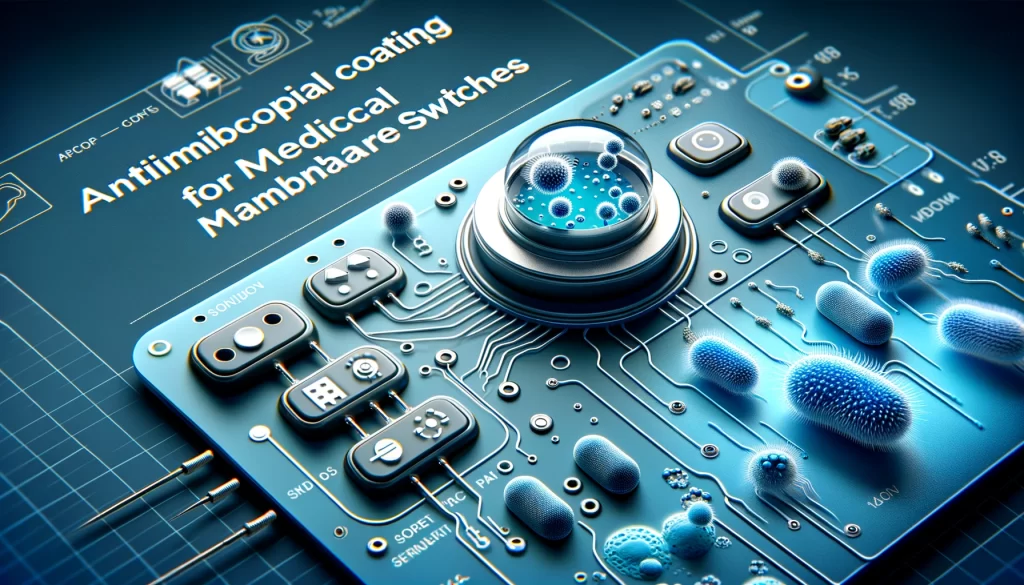Introduction
Hello, health tech experts and medical device manufacturers! In our ever-evolving medical field, one innovation that’s making a significant impact is antimicrobial coatings for membrane switches. Let’s delve into why this is a game-changer in medical device design.
The Need for Antimicrobial Protection in Medical Devices
Why It’s Crucial: In medical settings, the risk of infection and cross-contamination is a constant concern. Membrane switches on medical devices are frequently touched by different users, making them potential hotspots for microbes.
Enhancing Patient Safety: Antimicrobial coatings on these switches play a vital role in reducing this risk, offering an added layer of protection against harmful bacteria and viruses.
How Antimicrobial Coatings Work
The Science Behind It: These coatings contain substances that are lethal to microorganisms. When bacteria or viruses come into contact with the coated surface, the antimicrobial agents disrupt their cellular functions, effectively neutralizing them.
Sustained Protection: Unlike regular cleaning, which only offers temporary disinfection, these coatings provide continuous antimicrobial action, ensuring long-term hygiene and safety.
Integration into Membrane Switch Design
Seamless Application: Incorporating antimicrobial coatings into membrane switches doesn’t compromise their functionality or tactile response. The coatings are applied in a way that maintains the switch’s usability and durability.
Design Considerations: The challenge is to ensure that the coating is robust enough to withstand regular cleaning and usage, especially in high-traffic medical environments.
Advancements and Innovations in Coating Technologies
Next-Generation Coatings: The field is seeing exciting developments, like nano-coatings, which offer even more effective antimicrobial action without altering the physical properties of the switches.
Custom Solutions: Depending on the device and its usage, coatings can be customized in terms of composition and application methods to suit specific requirements.
Real-World Impact and Case Studies
Hospital Equipment
- Antimicrobial Coated Membrane Switches: Hospitals are environments where the risk of nosocomial infections (hospital-acquired infections) is high. Regular switches can harbor bacteria and viruses, contributing to the spread of infections. ElastoKey’s membrane switches with antimicrobial coatings can significantly reduce this risk.
- Reduction in Nosocomial Infections: By implementing these specialized switches in equipment like bedside monitors, nursing call buttons, and medical imaging devices, hospitals have observed a noticeable decrease in infection rates. This is because the antimicrobial coating disrupts the growth and spread of pathogens.
- Customization for Hospital Needs: Customization can include specific tactile feedback for gloved use, backlighting for visibility in various lighting conditions, and easy-to-clean surfaces to maintain hygiene.
Home Healthcare Devices
- Importance in Home Healthcare: Home healthcare devices, used by patients with compromised immune systems, need to be as sterile as possible. Devices like blood pressure monitors, portable dialysis machines, and respiratory therapy equipment are commonly used in home settings.
- Antimicrobial Coatings for Safety: Antimicrobial coatings on membrane switches in these devices play a critical role in preventing the growth of bacteria and viruses, which is especially important for immunocompromised patients.
- Custom Design Solutions: ElastoKey can customize these switches to be user-friendly for non-medical personnel, incorporating features like larger buttons for ease of use, clear labeling, and durable design to withstand frequent use.
The Role of Compliance and Standards
Meeting Medical Standards: It’s imperative that these coatings meet stringent medical standards for safety and efficacy, ensuring they are suitable for use in sensitive medical environments.
Future Directions and Sustainability
Eco-Friendly Options: The industry is also focusing on developing eco-friendly antimicrobial agents that are effective yet have a minimal environmental impact.
Conclusion
Antimicrobial coatings for membrane switches in medical devices represent a critical intersection of healthcare, safety, and technology. They’re not just an added feature but a necessity in our ongoing battle against infections. As we continue to innovate in this space, these coatings are set to play an increasingly vital role in ensuring the safety and efficacy of medical devices.




